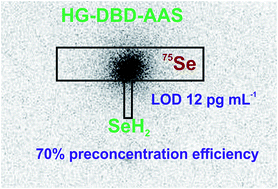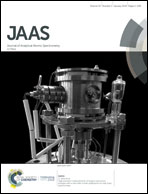Feasibility of in situ trapping of selenium hydride in a DBD atomizer for ultrasensitive Se determination by atomic absorption spectrometry studied with a 75Se radioactive indicator
Abstract
Preconcentration of selenium hydride in a planar dielectric barrier discharge (DBD) atomizer was optimized with detection by atomic absorption spectrometry. Addition of 3.5 mL min−1 O2 to the Ar plasma discharge resulted in the retention of selenium hydride in the optical arm of the DBD atomizer. Analyte release and subsequent atomization were achieved as soon as oxygen was switched off. Other parameters such as the discharge gas flow rate (75 mL min−1 Ar) and the discharge voltage (17 kV, corresponding power 14 W) were kept constant during the whole procedure. The use of a 75Se radiotracer combined with radiometry and autoradiography allowed proving efficient analyte trapping (>90%) in a small spot in the central part of the DBD optical arm whereas incomplete analyte release was found responsible for a preconcentration efficiency of 70%. The preconcentration method developed can be applied to real samples as demonstrated by accurate analysis of a GRUMO-K certified reference material achieving a detection limit of 12 pg mL−1 Se for a 300 s preconcentration period (sample volume 20 mL).



 Please wait while we load your content...
Please wait while we load your content...